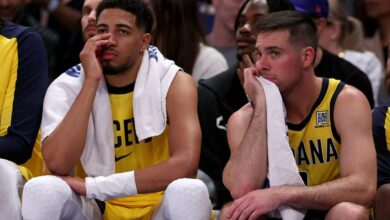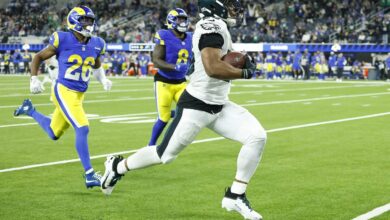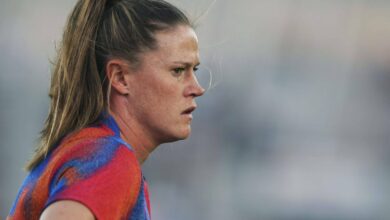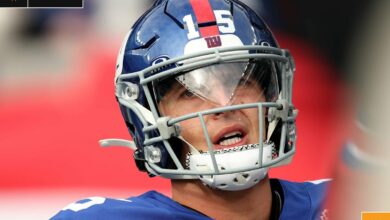A Former Hockey Enforcer Searches for Answers on C.T.E. Before It’s Too Late
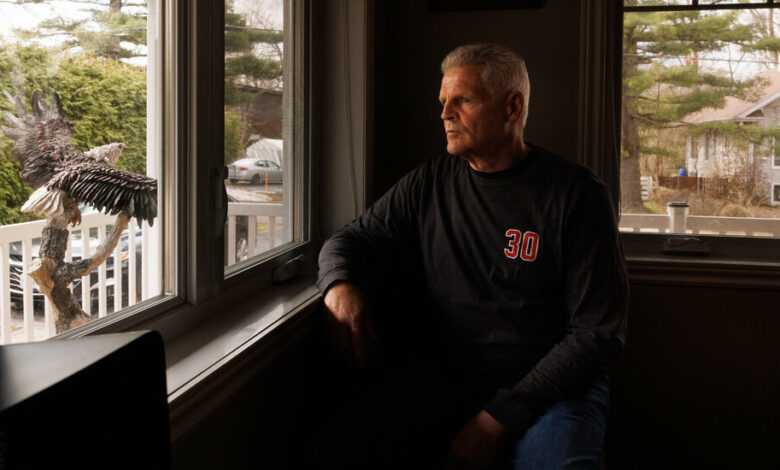
Page 68 of Boston University’s Hope Study questionnaire asks, “Have you ever injured your head or neck in a fight or been hit by someone?”
For Chris Nilan, a simple yes could never convey the whole story.
The answer stretches out over 300 bare-knuckle fights as a professional hockey player, and countless other brawls on the street corners of Boston beginning in his childhood. Most times, Nilan was the one dispensing the punishment. But hockey fights almost always involve mutual, bone-crushing blows, fists jackhammering from powerful shoulders, sometimes fracturing bones, tearing tissue and rattling brains.
The Hope Study, run by B.U.’s Chronic Traumatic Encephalopathy Center, has been measuring the brain health of living subjects with Alzheimer’s disease and related dementias since 1996. Nilan, curious about the condition of his brain after years of furious on-ice battles and eager to help with the research, turned to B.U., where participants return each year to repeat extensive testing, and eventually donate their brains. C.T.E. can only be diagnosed posthumously, but the Hope Study’s testing can provide valuable clues while patients are alive.
One of the key elements of the research is the background questionnaire, where subjects detail any history of brain impacts.
Nilan had played only a few N.H.L. games when, one night in 1980 as a rugged rookie for Montreal, he dropped his gloves and fought Boston’s Stan Jonathan and Terry O’Reilly, two of the most feared pugilists in league history. The bouts came in consecutive periods — hockey’s equivalent of boxing Muhammad Ali and Mike Tyson within an hour of one another.
Nilan, who was labeled Knuckles before he even turned pro, survived that night, plus 12 more seasons of fighting and scoring goals (118, including the playoffs). He won a Stanley Cup in 1986 with Montreal and was named an All-Star in 1991. Over his 13 years in the league, he fought an astonishing 316 times, the third most in N.H.L. history, according to the N.H.L. Fight Card database.
All of it was followed, coincidentally or not, by years of agonizing drug addiction, alcohol abuse and anger issues before Nilan settled into a quiet life in a Montreal suburb. An engaging, humorous sort with a Boston accent thicker than Chahles Rivah sludge, Nilan now hosts the “Raw Knuckles” podcast, fishes, cooks, reads every day — mainly books on military history — runs addiction recovery groups and spends quiet time with his fiancée, Jaime Holtz.
But if there was ever a high-risk candidate for C.T.E., the degenerative neurological disease associated with repeated impacts to the head or a body blows harsh enough to rattle the skull, Nilan would seem to fit the category.
Researchers have long suggested that the more hits to the head someone receives, including subconcussive ones, the more likely they are to develop cognitive and neurological problems later in life. A study earlier this year of football players’ brains suggested that the cumulative impact of multiple hits can also play a role.
Thirty years after retiring from an uncompromising, violent and successful career, and with the encouragement of the widow of a fellow enforcer who had the disease, Nilan signed up for the Hope Study.
“I don’t worry about having C.T.E.,” Nilan said. “But sometimes you wonder.”
Ten years ago, there might have been more concern. Nilan’s past substance abuse and outbursts of rage mirror some of the behavior exhibited by other hockey enforcers following retirement, players like Bob Probert, Derek Boogaard, Wade Belak, Todd Ewen and Steve Montador. All of them were diagnosed with C.T.E., which can only be detected after death.
More than a dozen hockey players have been diagnosed with C.T.E., and not all of them fighters. The most recent was Henri Richard, a small, skillful center for the Canadiens who died in 2020, the kind of player Nilan was paid to protect.
Nilan is 65 and sober now, still with a sharp wit and a vivid memory of a tumultuous and violent life that intersected closely with some of Boston’s most infamous figures, including James Bulger, the murderous crime boss, known as Whitey, who was Nilan’s father-in-law.
A Family History of Dementia
On April 17, Nilan entered the Hope Study. He and Holtz answered background questions from their home over a video conference call with researchers, who asked about Nilan’s family and behavioral history, his moods, his memory, his mother’s dementia and his career on the ice.
A few weeks later, he went to Boston for the cognitive and medical testing, and a month after that he received results that can give participants a snapshot of their brain health at that moment.
Nilan went into the study feeling healthy and robust, perhaps even a bit lucky. He empathizes with players who suffered from the same dangerous work that he did, but points no fingers.
In 2013, a group of former players sued the N.H.L. for not doing enough to address head injuries. Nilan was asked to join but declined, believing the sport did not cause his past substance abuse issues, and he does not regularly suffer from depression.
But because of his nearly unmatched history of fighting in hockey, Nilan has emerged as an important subject for researchers studying the effects of repetitive brain impacts and ways to detect it before death.
Even if he does not have C.T.E. or show signs of cognitive impairment, researchers will want to know why not, and what can be learned from it.
“That’s huge,” said Dr. Michael Alosco, the co-director of clinical research at Boston University’s C.T.E. Center. “Why do some people get it, and some don’t? What is different about them? It could be very informative for treatment and prevention.”
‘A Window Into the Brain’
A year ago, Dani Probert was a guest on Nilan’s podcast. They discussed her husband’s career and the time he tangled with Nilan on the ice. They recalled how Nilan and Bob Probert had become good friends after hockey, Probert’s addictions and his death in 2010 from a heart attack, at 45 years old.
Dani Probert explained that when she donated her husband’s brain to B.U.’s C.T.E. research center, she had difficulty answering an accompanying questionnaire about her husband’s life and career. She knew Probert was considered hockey’s heavyweight champion. But she did not know the details of every brutal punch, every check into the boards or fall to the ice.
She urged Nilan to answer those questions now, while he still could. A year later, Nilan joined the Hope Study and pledged to donate his brain.
“It’s vital to get athletes like Chris to participate,” said Chris Nowinski, the co-founder of B.U.’s C.T.E. Center and of the Concussion Legacy Foundation.
Over a day and a half in Boston, Nilan underwent a battery of medical, cognitive and neurological exams designed to help researchers learn the causes and effects of repetitive head impacts that can lead to C.T.E., and perhaps one day design a test that will detect it in living patients.
Nilan had his blood and spinal fluids drawn and was scheduled for magnetic resonance imaging of his brain. He tackled cognitive and memory tests involving word games, number sequences, short stories and mazes. One of the key tests is a lumbar puncture to draw spinal fluids that Dr. Alosco calls “a window into the brain.”
There are more than 400 participants in the program now, and about one third have been exposed to repetitive head impacts. Originally it focused on Alzheimer’s disease, but in recent years its C.T.E. research has expanded.
During the first day of testing in Boston, the city of his youth, Nilan had lunch with Dr. Alosco, who was curious about Nilan’s career and upbringing. Dr. Alosco asked if Nilan fought in college hockey and in high school. Nilan did not, but he casually mentioned some street fights. Asked how many, Nilan replied, “Oh, gosh, I couldn’t even tell you.”
More Than an Enforcer
In some ways, Nilan’s contribution to the study was an opportunity to do in retirement what he loved most as a player, defending teammates.
“If what I do now can help them figure out ways to detect C.T.E. earlier,” Nilan said, “maybe guys in the future can be forewarned and saved from further damage.”
On the ice, if an opposing player dared jam a stick blade into Guy Lafleur’s ribs or throw an elbow at Guy Carbonneau, they or their own enforcer answered to Nilan. When the other team was stocked with notorious tough guys, Nilan was the one expected to drop the gloves, absorb the crunching pain, and then weld someone’s eyes shut with his infamous knuckles.
“You’d go into Philly or Boston and you could see there were guys before the game who were scared,” Nilan said. “But I couldn’t be scared. I was the one they looked to blow the bugle, carry the flag and charge in there.”
Nilan accumulated 3,584 penalty minutes over the regular season and playoffs, the fifth-most in league history, and he played almost 300 fewer games than the top four offenders. He twice set the Canadiens record for most penalty minutes in a season: 338 in the 1983-84 regular season, and 358 the following year.
“I was a menace,” he said.
He was also one of the Canadiens’ most popular players, as much for his energetic goal celebrations as his fists. More than just a fighter, Nilan could play. In opposing arenas, he was the target of hatred and boos, even in Boston. But those who played alongside Nilan adored him.
“Chris Nilan was one of the absolute best teammates I ever had,” said Tony Granato, who played 13 years in the N.H.L., including his first two with Nilan on the Rangers, from 1988 to 1990.
A goal scorer, Granato recalled a game against the Pittsburgh Penguins in 1988 when he almost engaged in his first fight. When he returned to the bench, Nilan slid over hard and lectured him never to drop his gloves again. If there was a problem — with anyone — he should tell Nilan, who would take care of it. Nilan did the same for Brian Leetch, the star Rangers defenseman.
“There is guilt on my part for all the punishment he and those guys had to take for us,” Granato said. “But that was their job, and they took pride in it. No one did it better than Knuckles.”
Memory, Now and Five Years Ago
Chris Nilan is a quintessential Bostonian of a certain time and demographic, the kind they make movies about: A tough, working-class hockey player of Irish descent, hundreds, if not thousands, of local kids yearned to be just like him. He was born on Feb. 9, 1958, at the Faulkner Hospital in West Roxbury, Mass., the son of Henry and Leslie Nilan, a hard-working, blue collar couple who raised their four children in a strict household. Chris still found his way into scraps as a kid, and soon discovered he was a capable and fearless fighter. Often, he said, it was in defense of others. Later, he mixed it up with groups of kids and young adults on the streets and in the bars of Boston.
He met Karen Stanley at Northeastern University and they fell in love. When people asked about Bulger, Nilan would point out that he married Karen, not her stepfather. He described their 1981 wedding, with Henry Nilan’s Green Beret buddies on one side, Bulger and his cohorts on another and Nilan’s hockey pals up the middle.
“We could have invaded a small country,” Nilan said with a laugh.
Several years later, Bulger was photographed with the Stanley Cup after Nilan’s Canadiens won it in 1986. Nilan stresses he was never aware of Bulger’s criminal activities, but described tension between Bulger and his own father, an honest, taxpaying working man who disapproved of the then-reputed gangster’s “lifestyle.”
Once, when both sets of parents were visiting Montreal, Bulger bought Nilan’s mother an expensive fur coat, which upset Nilan’s father. Bulger adored Nilan’s fearless and pugnacious demeanor.
Waking In The Night, Punching or Kicking
At 6 feet, 205 pounds, Nilan was shorter and lighter than many of his opponents, like the 6-foot-5, 225-pound Dave Brown, whom he fought six times. Nilan relied on his remarkable stamina and developed a kind of rope-a-dope technique, tucking his head into one shoulder to protect his face and head and pouncing when the other fighter tired or allowed an opening. He quickly emerged as one of the most courageous and terrifying players in the league, willing to trade blows with any heavyweight.
Fighting is far less common in today’s N.H.L. than it was in the 1980s and ‘90s, as the league has ushered in rules modifications and a faster style of play, even though Gary Bettman, the league commissioner, still denies a link between fighting and C.T.E. Nilan opposes a ban on fighting, but acknowledges being sickened when a player is knocked unconscious in a fight.
It never happened to him, but in his later seasons, after he was traded to the Rangers and the Bruins, the fighting secretly wore him down.
“I fought right to the end, but it was getting harder on me,” he said. “Fight one guy and then fight another guy the next period or next shift. I’d come back to the bench and tell myself, ‘I’m losing that little edge,’ which you can never own up to. So you hide it.”
In the years after his career ended, his hands, knees and back throbbed from 13 years of pounding and too many surgeries. Nilan began ingesting Percocet, a prescription pain killer, and then became addicted to Oxycodone and alcohol, a familiar combination for many retired enforcers.
He eventually found heroin and took it intravenously. In 2015 his mother had a stroke and Nilan went to visit her at Faulkner, the hospital where he was born. He asked a drug dealer to meet him there and he snorted up in a maintenance closet. The next thing he knew, he was on a gurney with a nurse calling his name, yet another overdose victim.
Had he gone outside to find the dealer that night, instead of insisting they meet at the hospital, Nilan likely would not have survived.
He does not hide from the harrowing memory, or others, like the time decades ago when he savagely beat a young man who had hit his teenage daughter and was arrested in the assault. He grapples with the anguish he has inflicted on others, on himself, his family and Holtz.
And yes, he still wakes up, perhaps three or four times a year, throwing punches at the air in reaction to a nightmare, usually that he is being carjacked.
Problems With Anger
Nilan met Holtz in rehab and she has been his stanchion, guiding him out of relapses and back to recovery. The researchers asked Holtz about Nilan’s memory and moods and if he displayed moments of rage. She explained that several years ago, she told Nilan that if he did not get his anger under control, she would leave him.
“He would lose his temper for the smallest things,” she said. “Chris acknowledged those issues in his life and is completely different now. All of that has changed. He faced some hard truths and emotions and dealt with them. Growing up, that is how he was raised.”
Nilan adored his father, who died in 2021, and is immensely proud of him. Henry Nilan was a Green Beret in the Army reserves and a draftsman at Draper Labs in Cambridge, Mass., and he worked hard to provide for his family. He also hit Chris as punishment, sometimes in the chest, sometimes a slap to the back of the head, sometimes a punch, until Chris was about 16 and finally threatened to run away.
Growing up in that environment, he says, led to much of his anger and propensity to violence, not his career as an enforcer.
Have You Had Any Concussions?
Concussions are a concern, but not a prerequisite for C.T.E. Rather, the condition is believed to result from repeated impacts to the head.
“With C.T.E., concussions have been overemphasized,” Nowinski said.
Nilan recalls four possible concussions. One was from an opponent’s shoulder during play that left him dazed. Another time, as a fight wound down, Nilan’s opponent fell on top of his head as it struck the ice. Nilan saw stars. A third time was during a street altercation in Boston when he was struck in the head with a full bottle of beer and was, “out on my feet.” Lastly, several years ago he rolled his car into a ditch and was ejected out the back window, unconscious.
“I never felt any long-term symptoms,” he said. “I never had problems with light, or noise, or sleeping.”
‘Are you ready to hear the results?’
Nilan and Holtz sat in Nilan’s podcast studio in their home on June 8 and listened to Dr. Alosco and Hannah Bruce, a fellow researcher, present the findings. Nilan was eager to hear the results, and was also looking forward to interviewing Jim Montgomery, the Bruins’ head coach, for the podcast before heading out for a round of golf.
Holtz was nervous.
The results cannot rule out C.T.E., but they were very good for Nilan. His cognitive, memory and motor tests showed he was well within the normal range for his age, gender and education. In most he was above average. Had there been any reason for concern, Dr. Alosco would have recommended clinical care for diagnosis and treatment, which he did not consider necessary at the time.
“I kind of thought,” Nilan began, then paused and shook his head. “Look, I’m a special case.”
Everyone on the call laughed, but it could be true. Dr. Alosco said Nilan is in a very high-risk group and urged him to remain vigilant with his sobriety and a healthy lifestyle. He also asked him to return for the yearly research follow-ups, and Nilan said he would.
At the end of the meeting, Dr. Alosco stressed that researchers want to know the factors that have made Nilan appear resistant so far to degenerative neurological disease, whether genetics, medical history, the types of head impacts, his lifestyle or other factors.
“That’s why your data might be so valuable to answer who is resilient to these long-term effects of repetitive head impacts,” Dr. Alosco told Nilan.
Nilan was upbeat afterward, as he prepared to head out of the house. But not because of the results.
“Either way,” he said with a clap of his hands, “I was going to play golf.”
Audio produced by Kate Winslett.

